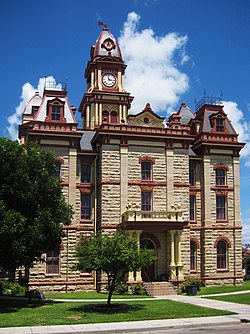Lockhart, Texas
| Lockhart, Texas | |
|---|---|
| City | |

|
|
| Nickname(s): Barbecue Capital of Texas | |
| Motto: City with a vision | |
 Location of Lockhart, Texas |
|
| Coordinates: 29°52′55″N 97°40′34″W / 29.88194°N 97.67611°WCoordinates: 29°52′55″N 97°40′34″W / 29.88194°N 97.67611°W | |
| Country | United States |
| State | Texas |
| County | Caldwell |
| GovernmentHome rule city | |
| • Type | Council – Manager |
| • Mayor | Lew White |
| • Mayor Pro Tem | Angie Gonzales-Sanchez |
| Area | |
| • Total | 15.6 sq mi (40.4 km2) |
| • Land | 15.6 sq mi (40.3 km2) |
| • Water | 0.04 sq mi (0.1 km2) |
| Elevation | 515 ft (157 m) |
| Population (2010) | |
| • Total | 12,698 |
| • Density | 810/sq mi (310/km2) |
| Time zone | Central (CST) (UTC-6) |
| • Summer (DST) | CDT (UTC-5) |
| ZIP code | 78644 |
| Area code(s) | 512 & 737 |
| FIPS code | 48-43240 |
| GNIS feature ID | 1374644 |
| Website | lockhart-tx |
Lockhart is a city in Caldwell County, Texas, United States. It is the county seat of Caldwell County. According to the 2010 census the population of Lockhart was 12,698. Lockhart and Caldwell County are within the Austin-Round Rock metropolitan area.
The city of Lockhart is named after Byrd Lockhart, an assistant surveyor of Green DeWitt and reportedly the first Anglo to set foot in Caldwell County. Lockhart was the site of a victory of the Texans over the Comanche, at the Battle of Plum Creek in 1840. Lockhart was originally called "Plum Creek" but the name was later changed to Lockhart.
The town's economic growth began with the arrival of the railroad in the late 19th century, at which time the town became a regional shipping center for local cotton. Following the arrival of the railroad, various immigrants arrived in Lockhart and opened various businesses.
Lockhart has several claims to fame. In 1999, the Texas Legislature proclaimed Lockhart the "Barbecue Capital of Texas"; Lockhart has four major barbecue restaurants. The Dr. Eugene Clark Library is the oldest operating public library in Texas. Lockhart was also the subject of an article by the architectural historian and critic Colin Rowe, first published in Architectural Record in 1957, and republished in the collection of his writings As I Was Saying (1996). Rowe sees Lockhart as a "curiously eloquent" example of a Victorian post-frontier American town.
Lockhart has played host to many film sets, as this quaint small town is located just 30 miles (48 km) south of Austin. The 1996 Christopher Guest comedy film Waiting for Guffman and the 1993 drama What's Eating Gilbert Grape were filmed partly in Lockhart, including the historic courthouse and the town square. The city's Wal-Mart store was featured in the 2000 film Where the Heart Is.
...
Wikipedia
